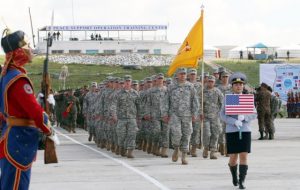Memo #173
By Jonathan Berkshire Miller – jbmllr [at] gmail.com
 Mongolia continues its rapid ascent in the strategic playbook of the United States and the West. The US views Mongolia through an integrated lens balancing its economic interests with strategic concerns. As the world’s fastest growing economy (GDP growth at 17.3 per cent in 2011), Mongolia is an appealing target for foreign investors in sectors such as mining, nuclear power, and technology. For Washington though, security still trumps in Mongolia. The US continues to view Mongolia as a credible partner in an uncertain area filled with truculent neighbours.
Mongolia continues its rapid ascent in the strategic playbook of the United States and the West. The US views Mongolia through an integrated lens balancing its economic interests with strategic concerns. As the world’s fastest growing economy (GDP growth at 17.3 per cent in 2011), Mongolia is an appealing target for foreign investors in sectors such as mining, nuclear power, and technology. For Washington though, security still trumps in Mongolia. The US continues to view Mongolia as a credible partner in an uncertain area filled with truculent neighbours.
In July, US Secretary of State Hillary Clinton praised Ulaanbaatar for being a model democracy in a region flush with kleptocratic regimes. Although not identified, Uzbekistan and Tajikistan come to mind as repressive states in the region and are rife with corruption. Clinton lauded Mongolia’s development noting that the Central Asian country’s progress helps “dispel the myth that democracy is a Western value.” During the visit, Clinton also used pointed language aimed at China, asserting that prosperity is connected to a free democratic system and the promotion of human rights.
Mongolia has long been part of Washington’s strategic calculus in Central Asia and its importance has been magnified by the war in Afghanistan. Currently there are more than 100 members of the Mongolian Armed Forces serving in Afghanistan as part of the International Security Assistance Force. Ulaanbaatar’s cooperation with NATO was formalized earlier this year when it signed an Individual Partnership and Cooperation Programme – which is slated to enhance interoperability with the alliance.
Mongolia also plays host to an annual gathering of militaries for “Khaan Quest.” The Khaan Quest exercises for 2012 just ended in August and was attended by 12 countries including the US, the United Kingdom, Germany, Japan, and Canada. Khaan Quest and NATO integration are two strong indicators of the important role that Ulaanbaatar plays as a strategic partner to the US.
As the US draws down its presence post-2014 in Afghanistan, it will look to credible partners such as Mongolia to be a leading example of transparency, democracy, and solid governance in Central Asia.
About the Author:
Jonathan Berkshire Miller is a fellow with the Center for Strategic and International Studies Pacific Forum and is a political and security analyst on Mongolia and the Asia-Pacific region with the Diplomat, which is based in Tokyo.
Links:
- Ten Things We Get from Mongolia (Pacnet #43), Center for Strategic & International Studies, July 2012.
- NATO and Mongolia agree programme of cooperation, North Atlantic Treaty Organization, March 2012.
- Multinational partners train in ‘Khaan Quest,’ U.S. Army, August 2012.
- Mongolia, The World Bank.
Related Memos:
- Our other Memos on Mongolia and the United States.
